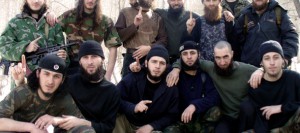Now that the Kremlin is proactively involved in Syria’s Latakia region – given Russia’s expansion of both the port facility at Tartus and an airfield, along with its dispersal of assets and humanitarian aid – the issue of where Chechens sit in the current milieu is of major strategic interest.
Of primary concern are those Chechens who are key leaders and tacticians in the Islamic State of Iraq and Syria (ISIS). These militants are particularly influential and cunning – and have long-term plans that include a violent return to the Russian Federation to spread the caliphate.
Chechens, by design or by fate of history, are again at the center of a battle that plays into their unique warrior lore.
Dr. Theodore Karasik
To be sure, Chechen fighters and field commanders have featured prominently in the uprising against Syrian President Bashar al-Assad. While a number of them may have departed directly from the Russian Federation, others are likely veterans or relatives of exiles in Europe, Turkey or the Levant from the two separatist Chechen Wars that took place in the 1990s. For those who are anti-Russian and anti-Grozny – the capital of Chechnya – the draw of ISIS’ so-called caliphate is strong.
Chechen fighters are involved in the senior ISIS leadership and in many of its attacks. One notable is Musa Abu Yusuf al-Shishani (aka Abu Omar al-Shishani), whose original name is Tarkhan Batirashvili. He is an ethnic Chechen from Georgia’s Pankisi valley and a senior military commander in ISIS. Al-Shishani is featured prominently in many ISIS videos. It will be interesting to see how Al-Shishani conducts his operations against the Russian “infidels” now that the Kremlin is backing Assad’s forces on Syrian ground.
Russia a target
To be sure, Islamic State has designs on the Russian Federation, which helps explain why the Kremlin is acting the way it is now in Syria. Chechens who are enemies of Moscow are key to penetrating Russia’s soft underbelly.
Maps issued recently by the Islamic State identified several caliphates it intends to establish within the next five years. One of these, the Qoqaz, imagines a unified Northern and Southern Caucasus caliphate. Unmistakably, the Russian Federation is now highly concerned – as demonstrated by recent pronouncements by the Russian Security Service (FSB) – as ISIS not only has significant influence on regional geopolitics, but serves as inspiration for extremist sympathizers around Russia’s borders and in allied countries in Central Asia, notably Kazakhstan and Tajikistan.
Aside from ISIS-affiliated Chechens, other Northern Caucasus ethnic groups including Circassians play a role in the Levantine war environment. Circassians are present in the Syrian military, as are others from the Northern Caucasus who immigrated to Damascus over the past century. There are families in Syria that have ancestral ties with Kabardino-Balkaria, Ingushetia, and Dagestan. How these ethnicities see Russia’s presence in Syria now will be part of “squaring the circle” between the Levant and the Northern Caucasus.
Anti-Russian hatred
Syrian counter-intelligence always considered these ethnic groups “non-Arab”. We need to recall anti-Russian hatred that manifested itself early in the Syrian revolt, which featured the burning of Russian flags and other violent acts. In addition, when speaking of Chechens in Syria, there needs to be an important distinction of who is actually a Chechen or is instead related to another ethnic group from the Russian Federation. Clearly, the festering ethnic issue of minorities in the Levant may rise up; Moscow and Damascus should take note.
Nevertheless, there are, of course, Chechens aligned with the Kremlin on the Syria issue. Chechen President Ramzan Kadyrov already called ISIS the “Iblis State” – State of Satan – which demonstrates his absolute contempt for the Caliphate. More importantly, Kadyrov is playing a key role in acting as an intelligence arm in cooperation with Moscow, Damascus and, significantly, Amman. In June 2014, King Abdullah of Jordan visited Chechnya to meet with Kadyrov. From there on out, Amman and Grozny, along with Moscow, in a significant triangulation, have been sharing intelligence information on Chechens and other Russian citizens in ISIS. Moreover, Chechnya’s counterterrorism forces are prominently displayed in Chechnya to the point of setting up an international training center in Gudermes earlier this year modeled on the King Abdullah II Special Operations Training Center (KASOTC).
Hunter-killer teams
The Kremlin’s plan appears to be for Russian forces to be augmented with Kadyrov’s hunter-killer teams in Syria. This move, supported by Jordan and other Arab countries, has been in the works for over a year. As a force multiplier, Kadyrov’s forces actually know how their Islamic State opponents think and act on the battlefield. That’s an important requirement – boots on the ground – and an irony that Kadyrov’s Chechen counterterrorism fighters are going to “save the day” in Syria. This plan is what one reaps from relying on air power alone by the U.S.-led Operation Inherent Resolve. To be determined is how the pro-Moscow Chechens will cooperate and interoperate with other players in the Syrian battle-space.
Unmistakably, Chechens, by design or by fate of history, are again at the center of a battle that plays into their unique warrior lore. But this Levantine battle is different because this fight will be outside their home territory and ultimately, against each other. In other words, the spread of Chechen politics and violence, sharply divided since Moscow imposed its will in Grozny through the Kadyrov clan, is now being transported into the heart of the Levant. It will be an epic battle – and all sides know it.
syriahr.com



